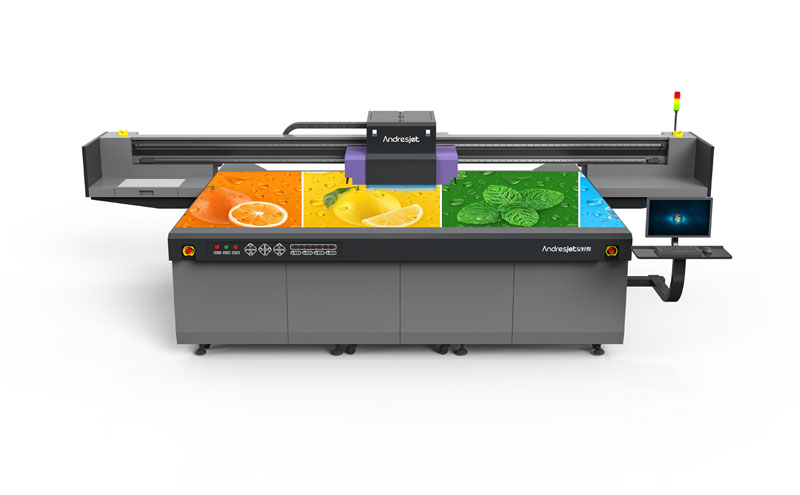UV Flatbed Printer: An Insight Into the Printing Process
UV Flatbed Printer: An Insight Into the Printing Process
In the realm of digital printing, UV flatbed printers have emerged as a game-changer, revolutionizing the way images and designs are transferred onto various surfaces. This technology, known for its versatility and precision, has found applications in diverse industries, from advertising and signage to packaging and decorative arts. This article delves into the intricacies of UV flatbed printing, exploring its working principles, advantages, applications, and the future prospects of this innovative technology.

Understanding UV Flatbed Printers
UV flatbed printers are a type of digital printing machinery that utilize ultraviolet (UV) light to cure or dry ink instantly after it is applied to a substrate. This process allows for the printing of high-quality images on flat or slightly curved surfaces, making it suitable for a wide range of materials such as glass, wood, metal, plastics, and even certain types of fabrics. The key components of a UV flatbed printer include the print head, ink supply system, UV curing system, and the control software.
The Printing Process
Preparation Stage: Before the actual printing begins, the substrate needs to be prepared. This involves cleaning the surface to remove any dust, oil, or contaminants that might affect the print quality. Depending on the material, pretreatment might also be necessary to enhance ink adhesion.
Design and File Preparation: The digital design is created or selected and prepared for printing. This includes adjusting the resolution, color correction, and sizing the image to fit the substrate. The design is then sent to the printer’s control software.
Printing: Once the substrate is loaded onto the printer’s flatbed, the print head moves across the surface, depositing ink droplets in precise patterns to form the image. UV flatbed printers typically use piezoelectric technology, which allows for highly accurate dot placement and variable dot sizes, resulting in sharp, detailed prints.
UV Curing: Immediately after the ink is deposited, it is exposed to UV light. This light initiates a chemical reaction in the ink, causing it to cure or dry instantly. This process not only speeds up production but also ensures that the ink is durable and resistant to fading, scratching, and environmental factors.
Post-Processing: Depending on the application, additional steps such as cutting, laminating, or applying a protective coating might be required after printing. These steps further enhance the finished product’s durability and appearance.
Advantages of UV Flatbed Printing
Versatility: UV flatbed printers can print on a wide variety of materials, making them ideal for diverse applications.
High Quality: The prints produced are of high resolution, with vibrant colors and sharp details, making them suitable for high-end applications.
Efficiency: The instant curing process allows for faster production times compared to traditional printing methods.
Durability: UV-cured inks are highly resistant to fading, scratching, and chemicals, ensuring long-lasting prints.
Environmentally Friendly: UV printing is a more eco-friendly option as it reduces waste and energy consumption compared to some other printing methods.
Applications of UV Flatbed Printing
Advertising and Signage: UV flatbed printers are extensively used in the production of outdoor and indoor signs, banners, posters, and displays due to their ability to print on a variety of materials and withstand environmental conditions.
Decorative Arts: Artists and decorators leverage this technology to create unique pieces on materials like glass, wood, and metal for home and commercial decor.
Packaging: UV flatbed printing is increasingly used in packaging, allowing for the direct printing of high-quality graphics onto boxes, containers, and other packaging materials.
Industrial Applications: Industries such as automotive and aerospace utilize UV flatbed printing for prototyping, part marking, and custom designs on various components.
Personalized Products: With the rise of customization, UV flatbed printers are used to create personalized gifts, phone cases, and other accessories.
Future Prospects
As technology continues to advance, the capabilities of UV flatbed printers are expected to expand further. Improvements in ink formulations will lead to even more durable and environmentally friendly prints. The integration of advanced software and automation will streamline the printing process, reducing manual intervention and increasing productivity. Additionally, the development of new materials compatible with UV printing will broaden the scope of applications, pushing the boundaries of what can be achieved with this technology.
In conclusion, UV flatbed printing has revolutionized the printing industry by offering a versatile, efficient, and high-quality solution for a wide range of applications. Its ability to print on various materials, coupled with the durability of UV-cured inks, makes it a preferred choice for many businesses and industries. As technology progresses, UV flatbed printing is poised to become even more integral to the manufacturing and creative sectors, driving innovation and pushing the limits of digital printing.
